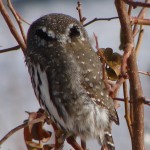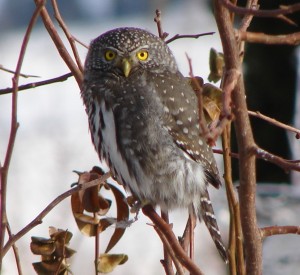One of the more diminutive members of the Owl family is the Northern Pygmy Owl (Glaucidium gnona) which is 6”-61/2” (15-17 cm) in size. These pictures were taken on January 8th, 2009 the second picture shows that it has “Eyes in the back of its head”, this must be very confusing to both predator and prey. Scientists believe that this evolutionary adaptation is meant to keep smaller birds which are its prey from “mobbing” (attacking or harassing).
 The Northern Pygmy Owl is closely related to the Ferruginous Pygmy Owl whose range is the Southwestern United States. Both the Northern and Ferruginous are diurnal (opposed to most owls which are nocturnal) and is active from dawn to dusk. The ability to have better vision at night is a function of the numbers of rods and cones present in the eye. Cones are adapted to distinguish color and rods are adapted for low light. Owls have many more rods in the retina of their eye than do humans, some owls species eyes are approximately 100 times more sensitive at night than those of humans; hence giving them extremely good night vision.
The Northern Pygmy Owl is closely related to the Ferruginous Pygmy Owl whose range is the Southwestern United States. Both the Northern and Ferruginous are diurnal (opposed to most owls which are nocturnal) and is active from dawn to dusk. The ability to have better vision at night is a function of the numbers of rods and cones present in the eye. Cones are adapted to distinguish color and rods are adapted for low light. Owls have many more rods in the retina of their eye than do humans, some owls species eyes are approximately 100 times more sensitive at night than those of humans; hence giving them extremely good night vision.
In the South Okanagan the Northern Pygmy Owl makes his home at the higher elevations between 700 and 1500 meters during the breeding season. During the winter the months of December and January he is regularly seen on the valley floor where the snowfall is less and prey more abundant.
To learn more about this bird contact Great Horned Owl Eco Tours




I was very fortunate to have this tiny raptor hang around my yard for a couple of weeks, During that time I came to realize what an incredible and aggressive hunter he is as picked off small birds like Juncos. Ounce for Ounce he is perhaps the most fearsome of the owl family.
Beautiful shots!